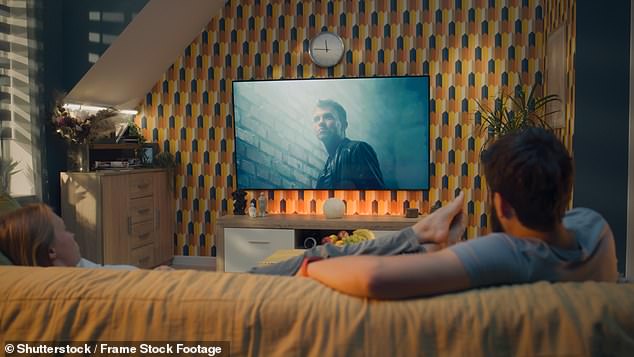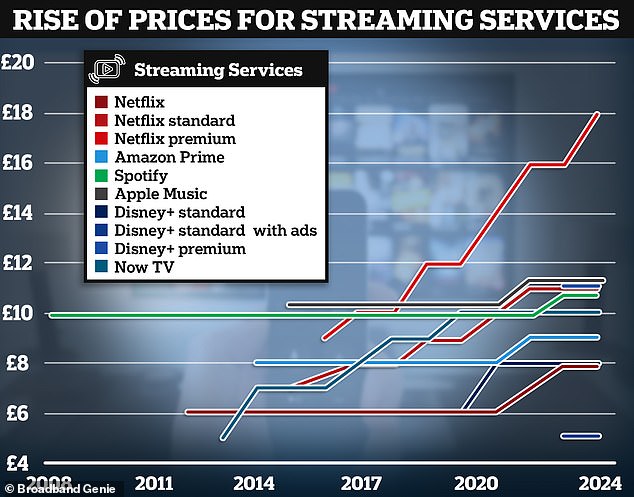As digital music becomes the norm and more hit shows premiere online rather than on TV, services like Spotify and Netflix have gone from being a nice extra to a must-have for lots of households.
Streaming platforms have grown in popularity and number, and the firms behind them have also hiked their prices, ramping up the total monthly cost.
Amazon Prime is the latest to announce such a rise, and will start showing adverts from 5 February 2024 unless users pay an extra £2.99 a month.
We look at how much popular platforms have increased prices since they launched, and how the introduction of cheaper ‘basic’ options might save you some cash.

Serial hikes: Streaming platforms have all put up their prices in recent years
How much have streaming platforms hiked prices?
The price of streaming platforms held steady for a number of years until the pandemic and changing consumption habits triggered a wave of price hikes.
Since 2019, all main TV and music streaming platforms in the UK have increased their prices by at least £1 per month.
Amazon Prime’s recent price hike means that those with a standard subscription who want to continue watching ad-free will see their bill go from £8.99 a month to £11.98 a month. This follows a rise from £7.99 to £8.99 in 2022.
Those who have the Prime Video-only subscription, which does not include other services such as free next-day delivery on Amazon shopping, will see their bill rise from £5.99 a month to £8.98 a month.
Netflix has had the most frequent price increases in recent years, however. Since its launch in 2012, prices rose steadily from £5.99 to £7.99 by 2018 for its standard package, which allows users to watch on two devices at a time.
By 2019, the price of a standard package had increased from £7.99 to £8.99, and from £9.99 to £11.99 for its premium package, which allows users to watch on 4 devices at a time.
In 2021, Netflix’s standard package increased from £8.99 to £9.99 while premium customers paid £13.99 a month, up from £11.99 the previous year.
In 2022, Netflix hiked prices again with the premium package rising from £13.99 to £15.99, while its basic and standard plans increased by £1 to £6.99 and £10.99 respectively.
By 2023, its basic plan was no longer available to new customers, but rose to £7.99 for existing customers, while its standard plan with ads remains at £4.99.
Its premium package rose from £15.99 in 2021 to £17.99 in 2023, rising £8, or 80 per cent, in five years.
Disney+ has had the steepest increases, though. It launched in 2020 for £5.99 a month but hiked prices by £2 just a year later. In 2023, it increased prices again – from £7.99 to £10.99 – marking a 37.5 per cent increase in just a year, and an 83 per cent rise since its launch.

Music platforms have remained largely flat, although both Apple Music and Spotify have raised their subscriptions by £1 since 2022.
Since its 2008 launch, Spotify held off rising prices on its premium plan until last year, when it rose from £9.99 to £10.99.
Similarly, Apple Music increased its subscription by a £1 to £10.99 in 2022, for the first time since its launch in 2015.
If you subscribed to one music service as well as Amazon Prime and Netflix’s standard subscription – the most popular platforms – in 2020, it would have set you back £26.97 per month.
Now it would cost £32.97 if you opted for Prime without adverts.
Can you save with basic subscriptions?
One of the biggest changes to streaming platforms in recent years has been the introduction of different plans for different price points.
Netflix has been a pioneer of this tiered system, introducing the premium subscription in 2016.
But the price gap between the basic and premium tiers is widening across several platforms.

Tier pioneers: Netflix was one of the first to offer subscriptions at different price points
Alex Tofts, broadband expert at Broadband Genie said: ‘The premium plan offered by Netflix, which features Ultra HD video streaming and more devices able to view at the same time, now costs £17.99 per month.
‘This means the monthly price has almost doubled in the last five years, forcing TV buffs to pay up, or compromise on quality and embrace adverts.’
Why are streaming services charging more?
As more streaming services have launched, households are being forced to make decisions about which ones they do and don’t keep subscribing to.
Therefore, firms have been under pressure to hike their prices in order to keep making a profit amid tougher competition.
Some have also spent money on producing their own shows – a cost which is passed on to the customer.
Netflix’s standard subscription without ads has increased by over 80 per cent since it launched in the UK in 2012.

Amazon Prime will introduce adverts for its standard subscription from the end of January
This has largely been about improving the company’s bottom line after spending years investing millions into programming.
Since interest rates have soared over the past year and a half, investors have grown impatient with their losses.
Netflix in particular has come under pressure to limit loss making, hence the introduction of new tiers and price hikes.
It is also why Netflix has led the charge on cracking down on password sharing, something Disney boss Bob Iger has also suggested he might do.
The introduction of adverts is another development for the industry. From next month Amazon Prime will start to incorporate ads into its streaming service, with customers given the option to pay more to keep avoiding adverts.
Tofts said: ‘It is clear that streaming providers are pushing people towards watching ads, with Amazon Prime Video recently announcing that all customers will soon be forced to see them unless they pay an additional £2.99 per month.
‘Meanwhile, premium Netflix customers could save £13 per month by switching to the standard package with ads, while those with Disney+ Premium could cut their bills in half by switching to the standard with ads option.’
Some links in this article may be affiliate links. If you click on them we may earn a small commission. That helps us fund This Is Money, and keep it free to use. We do not write articles to promote products. We do not allow any commercial relationship to affect our editorial independence.




